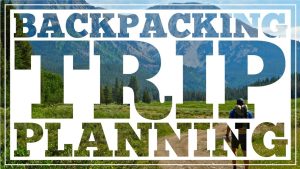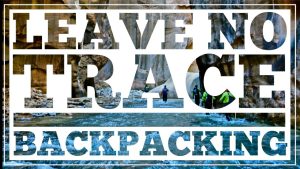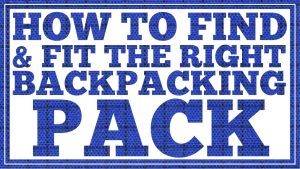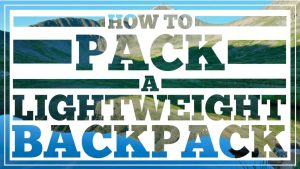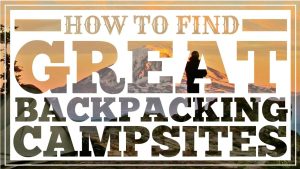Ep. 8 – Protect Your Food – Keep Wildlife Wild
We independently test everything we recommend.
Buying through links on our site supports our work.
Backpacking Food Storage – Bear Bagging & Canisters
Storing your food properly at night is not just a skill that’s good for you, it’s also good for the wildlife around you. If you keep your food safe, you won’t go hungry, and you’ll also prevent scavenging animals from getting an easy meal.
Learning to associate humans with food will alter an animal’s foraging instincts and they can quickly become pests. When animals become pests, it’s generally very bad news for them. For example, if a bear learns that humans provide easy meals, they will frequent established campsites looking for human food. When that happens, the bear might have to be relocated or killed. So protect your food as best as possible. If not for your sake, for the wildlife around you.
Food Storage Tips
Take your food with you when you’re on a backpacking trip. Even if you’re setting up a base camp and doing day hikes, you should always bring your food bag. Small rodents can easily chew through a shelter or a backpack to get into your food supply if it is left unattended which will ruin your gear and your meals.
Items that smell strongly should be treated like food too. Bug spray, sunscreen, toothpaste, and other strong smelling items are also attractive to animals, so they should be stored with your food at night.
If you’re leaving your pack outside overnight, consider opening the zippers so small critters will easily be able to see that there isn’t any food in your pack. Some animals may gnaw through your bag during the night in the hopes of finding food even if there isn’t any there.
Store your food at least 100 feet away from your sleeping area to give yourself adequate distance from any animals that might be trying to get at your food.
Sometimes your larger animals like bear and deer will be interested in your food, but often it’ll be smaller rodents like mice, chipmunks, and squirrels that you’ll need to deter.
Food Storage Methods
When it comes to nighttime food storage, there are two common methods that backpackers use.
1) The fist technique is to keep food away from animals by hanging it in a bag that will be out of reach.
This method is commonly referred to as bear bagging and there are a few different effective techniques to do it.
2) The second technique is to put your food in a container that animals won’t be able to get into.
Bear canisters and ursacks are two common tools used for this method and both are quite effective.
How to Hang a Bear Bag – PCT Method
If you’re planning to use the bear bag method, make sure you do it correctly. Bears are very smart and a poorly hung bag won’t be much of a challenge for a smart bear.
It’s a good idea to hang your bear bag well before it gets dark. It’s much easier to hang your bag while you still have daylight and it will often take longer than you think, especially on your first few attempts.
One of the easiest and most commonly used methods is the PCT style of bear bag hanging. There are plenty of other methods, but I find that this one work very well. For this method you’ll need: lightweight chord, a weatherproof sack for food, a small carabineer, and a small stuff sack for holding a rock.
PCT Method
- First, put all of your food and any strong smelling items in your weatherproof sack. Some backpackers use odor resistant bags to reduce the scent of your food as well.
- Find a tree with a solid trunk and a tall branch (about 20 feet or so) that sticks out at least 4 feet from the base of the tree. Picking the correct tree and branch is key.
- Next, tie a rock to the end of a lightweight nylon rope or use a small stuff sack to hold your rock. Tie the other end to an anchor tree, so you don’t loose the entire rope up in the tree.
- Then toss the rock and rope over the tree branch. Repeat this step until you get it right.
- Tie your carabineer to the end of the rope and clip your food bag to the carabineer. Clip the other end of your rope through the carabineer and pull the bag up to the top of the limb.
- With your food bag at the top of the branch, tie a stick into the rope.
- When you let the bag down, this stick won’t allow the rope to pass through the carabineer, so your food bag will be suspended in the air.
Make sure your bag is hanging at least 12 feet in the air and at least 4-5 feet away from any trees.
If you can’t get your bag far enough away from the base of the tree, lower the bag and use the alternate PCT method.
Alternate PCT Method
- Don’t clip the rope into the carabineer this time, pull the bag up to the limb and tie the stick into the rope.
- Then lower the bag and clip the rope into the carabineer.
- Now the stick won’t let the bag slide any farther up the rope so you can pull it away from the tree and tie off the base to another tree.
- Tie the rope high so bears won’t be able to claw at it.
Bear bagging can be effective if done correctly, but there are some downsides to this method. It will take time and practice to perfect your method. A poorly hung bag will be an easy target for bears.
Finding the right trees can sometimes be difficult. And even if you do your absolute best, there are some very determined bears out there that might be able to get into your food.
Bear Canisters and Ursacks
The alternative to bear bagging is placing your food in a sealed container that animals won’t be able to get into. Bear Canisters and Ursacks are the two containers that are most commonly used. This method will save you time and give you more piece of mind about the safety of your food, but it will also require you to carry more weight.
Bear canisters are considered the most secure way to store your food and, for that reason, they are mandatory for travel in some popular backcountry areas. The downside to bear canisters is that they are heavy, they have limited storage space, and they can be obnoxious to pack in your bag.
An Ursack is a strong bag made out of Kevlar fabric that will to protect your food like a bear canister. You tie the bag securely to a tree at night and animals can’t get in. An Ursack will be lighter than a bear canister and easier to pack in your backpack. Ursacks are a very effective food storage method but they aren’t currently approved for travel in many areas that require bear canisters for backcountry travel.
Wrap Up
Whatever method you choose to use, always make sure to secure your food and scented items before you turn in for the night. Remember, it’s for the animal’s protection as much as it is for your own.
If you enjoyed this article and video, click the little heart below to give me a digital high five! Also, leave me a comment below with any questions or thoughts and I’ll respond as soon as possible. Thanks!
MORE EPISODES IN THIS SERIES
View all